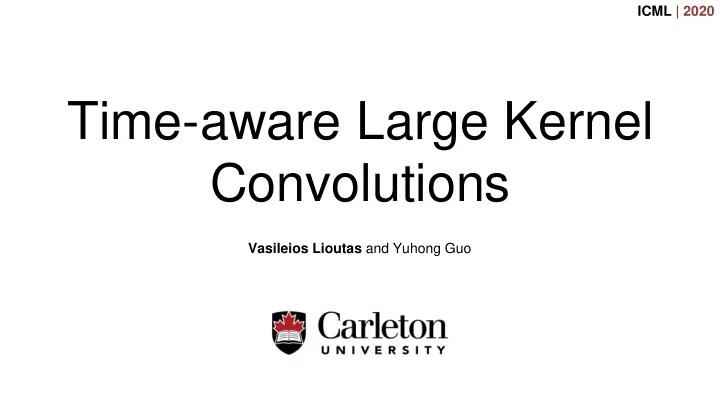

ICML | 2020 Time-aware Large Kernel Convolutions Vasileios Lioutas and Yuhong Guo
ICML | 2020 Brief Overview ● In this work, we introduce a novel sequence modeling approach called TaLK convolutions that is not based on self-attention. ● The proposed method has time complexity and it uses an adaptive summation convolution kernel. ● Experiments on machine translation, abstractive summarization and language modeling suggest that this method can yield comparative results with other self-attention and convolution based competitive methods.
ICML | 2020 Introduction ● Sequence modeling is a fundamental task in ML ● It's the process of learning how to combine timesteps to form representations of higher abstraction. [Karpathy, 2015] ● Many applications such as machine translation, POS tagging, sentiment classification, video processing, time-series etc.
ICML | 2020 Sequence Modeling Approaches
ICML | 2020 Sequence Modeling Approaches
ICML | 2020 Sequence Modeling Approaches
ICML | 2020 Comparison
ICML | 2020 Motivation Currently, self-attention is considered vital for modern sequence learning approaches. ● Self-attention is expensive . It has quadratic time complexity. ● Hard to be deployed on devices with limited hardware (i.e. edge devices) ● Dynamic Convolutions [Wu et al. 2019] showed that you can achieve good results using a limited context window . ● Still relies on a special type of attention (i.e. dynamic value-based attention)
ICML | 2020 Research Questions ● Q1: Is (self-)attention critical to get good performance? ● Q2: Can we reduce the time-complexity to using a parallelizable non-autoregressive method?
ICML | 2020 One-dimensional Large Kernel Convolution ● One of the simplest ways to model a sequence of representations is to aggregate the appropriate number of vector representations together. where are the left and right offsets (boundaries).
ICML | 2020 One-dimensional Large Kernel Convolution
ICML | 2020 Summed-area Table ● Applying the previous aggregation can be slow because we compute the same aggregations again and again. ● To address this issue we can use the summed-area table (integral image operation). ● Let be the summed-area table computed using ● The above operation can be efficiently parallelized with complexity using the parallel prefix sum algorithm. ● Given the left and right offsets, we can compute using the summed-area table in time:
ICML | 2020 Time-aware Large Kernel Generation ● So far, we assumed that and are given. ● Ideally, we want to learn to generate these offsets for each input timestep. ● We can’t directly predict the index which corresponds to the offset word: ● Indexes are positive unbounded integers; ● We address this issue using relative offsets. ● We generate these relative offsets using where
ICML | 2020 Offsets Interpolation ● Convert the relative offsets to absolute by using where are the maximum allowed tokens to the left and to the right. ● We can’t directly use the absolute indexes because they are real values. ● We use linear interpolation to approximately generate and directly:
ICML | 2020 Output Normalization ● The proposed method works well when used with shallow models. ● Aggregating many representations together can lead to disproportional magnitude on the representation values passed to the next layers. ● Solution: Normalize by the maximum window length ● To further increase the performance, we apply dropout to the generated relative offsets ● Set relative offset to zero which effectively cancels the expansion of the window towards that direction. ● Forcing the model to produce smaller windows to robustify the importance of the number of tokens that are needed to model a timestep.
ICML | 2020 Multi-headed Kernels ● Similar to MHSA, we introduce multiple heads. ● We tie every subsequent number of channels together and group the channels into groups. where . ● This helps to further increase the expressivity and diversity of the representation of each timestep.
ICML | 2020 The TaLK Convolution Operation
ICML | 2020 Architecture & Implementation ● We implemented our own CUDA primitives to support the TaLK Convolution operation.
ICML | 2020 Computational Complexity
ICML | 2020 Machine Translation
ICML | 2020 Abstractive Summarization & Language Modeling
ICML | 2020 Model Ablation
ICML | 2020 Encoding Inference Speed Comparison
ICML | 2020 Conclusion ● We introduced a new way of doing sequence modeling that has time complexity. ● The results show that the proposed method can perform on par with transformers and dynamic convolutions without using self-attention or a variant of it. ● In the future, we will do more research on how to apply TaLK Convolutions in a non-contiguous way. Thank you! github.com/lioutasb/TaLKConvolutions
Recommend
More recommend